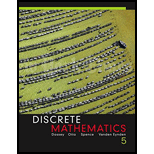Solutions for Discrete Mathematics
Problem 11E:
In Exercises 1-16, calculate the number shown.
11.
Problem 12E:
In Exercises 1-16, calculate the number shown.
12.
Problem 16E:
In Exercises 1-16, calculate the number shown.
16.
Problem 17E:
A baseball manager has decided who his 9 starting hitters are to be, but not the order in which they...Problem 18E:
A president, vice president, and treasurer are to be chosen from a club with 7 members. In how many...Problem 22E:
Different prizes for first place, second place, and third place are to be awarded to 3 of the 12...Problem 24E:
A farmer with 7 cows likes to milk them in a different order each morning. How many days can he do...Problem 28E:
A dinner special for 4 diners at a Chinese restaurant allows one shrimp dish (from 3 selections),...Problem 32E:
Show that if 0 ≤ 2r ≤ n, then .
Browse All Chapters of This Textbook
Chapter 1 - An Introduction To Combinatorial Problems And TechniquesChapter 1.1 - The Time To Complete A ProjectChapter 1.2 - A Matching ProblemChapter 1.3 - A Knapsack ProblemChapter 1.4 - Algorithms And Their EfficiencyChapter 2 - Sets, Relations, And FunctionsChapter 2.1 - Set OperationsChapter 2.2 - Equivalence RelationsChapter 2.3 - Partial Ordering RelationsChapter 2.4 - Functions
Chapter 2.5 - Mathematical InductionChapter 2.6 - ApplicationsChapter 3 - Coding TheoryChapter 3.1 - CongruenceChapter 3.2 - The Euclidean AlgorithmChapter 3.3 - The Rsa MethodChapter 3.4 - Error-detecting And Error-correcting CodesChapter 3.5 - Matrix CodesChapter 3.6 - Matrix Codes That Correct All Single-digit ErrorsChapter 4 - GraphsChapter 4.1 - Graphs And Their RepresentationChapter 4.2 - Paths And CircuitsChapter 4.3 - Shortest Paths And DistanceChapter 4.4 - Coloring A GraphChapter 4.5 - Directed Graphs And MultigraphsChapter 5 - TreesChapter 5.1 - Properties Of TreesChapter 5.2 - Spanning TreesChapter 5.3 - Depth-first SearchChapter 5.4 - Rooted TreesChapter 5.5 - Binary Trees And TraversalsChapter 5.6 - Optimal Binary Trees And Binary Search TreesChapter 6 - MatchingChapter 6.1 - Systems Of Distinct RepresentativesChapter 6.2 - Matching In GraphsChapter 6.3 - A Matching AlgorithmChapter 6.4 - Applications Of The AlgorithmChapter 6.5 - The Hungarian MethodChapter 7 - Network FlowsChapter 7.1 - Flows And CutsChapter 7.2 - A Flow Augmentation AlgorithmChapter 7.3 - The Max-flow Min-cut TheoremChapter 7.4 - Flows And MatchingsChapter 8 - Counting TechniquesChapter 8.1 - Pascal's Triangle And The Binomial TheoremChapter 8.2 - Three Fundamental PrinciplesChapter 8.3 - Permutations And CombinationsChapter 8.4 - Arrangements And Selections With RepetitionsChapter 8.5 - ProbabilityChapter 8.6 - The Principle Of Inclusion-exclusionChapter 8.7 - Generating Permutations And R-combinationsChapter 9 - Recurrence Relations And Generating FunctionsChapter 9.1 - Recurrence RelationsChapter 9.2 - The Method Of IterationChapter 9.3 - Linear Difference Equations With Constant CoefficientsChapter 9.4 - Analyzing The Efficiency Of Algorithms With Recurrence RelationsChapter 9.5 - Counting With Generating FunctionsChapter 9.6 - The Algebra Of Generating FunctionsChapter 10 - Combinatorial Circuits And Finite State MachinesChapter 10.1 - Logical GatesChapter 10.2 - Creating Combinatorial CircuitsChapter 10.3 - Karnaugh MapsChapter 10.4 - Finite State MachinesChapter A - An Introduction To Logic And ProofChapter A.1 - Statements And ConnectivesChapter A.2 - Logical EquivalenceChapter A.3 - Methods Of ProofsChapter B - Matrices
Sample Solutions for this Textbook
We offer sample solutions for Discrete Mathematics homework problems. See examples below:
The given network diagram does not have any arrows. Thus, by default consider all the edges are...The universal set is U={1,2,3,4,5,6}. The given sets are A={1,2,3,4} and C={3,5,6}. The intersection...Procedure used: Procedure to check the divisibility. 1 Consider the syntax congruence provided. 2...Let G be a given graph. Label the vertices of the given graph as follows. The complement of the...Theorem used: The minimum number of edges for n vertices. e=n−1 Here, e represents the edge....Given: The sequence of set is {1,2,3,4,5},{1,2,3,4,5},{1,2,3,4,5}. Concept used: If the finite...Given: The network is shown in Figure 1. Concept used: Flow Augmentation Algorithm For a...Formula used: Number of different r-combination: The number of different r-combinations of a set of...The given Sequence is sn=3sn−1+n2 for n≥1. Obtain the fifth sequence as follows. Compute the first...
More Editions of This Book
Corresponding editions of this textbook are also available below:
Discrete Mathematics - Student Solutions Manual - Dossey - Paperback
5th Edition
ISBN: 9780321305176
Discrete Mathematics
5th Edition
ISBN: 9788131766262
Discrete Mathematics
5th Edition
ISBN: 9780321305152
Instructors Solutions Manual To Discrete Mathematics 3e
3rd Edition
ISBN: 9780673977953
Related Math Textbooks with Solutions
Still sussing out bartleby
Check out a sample textbook solution.
